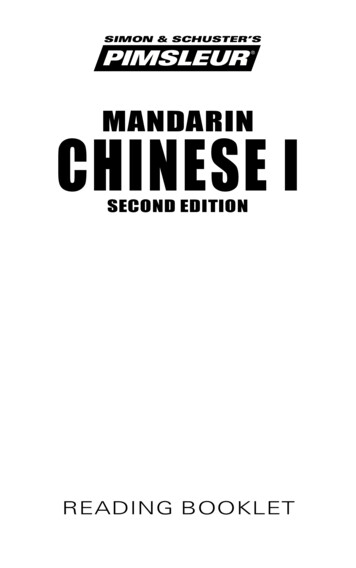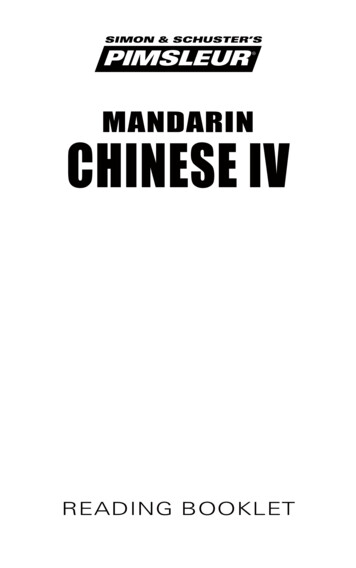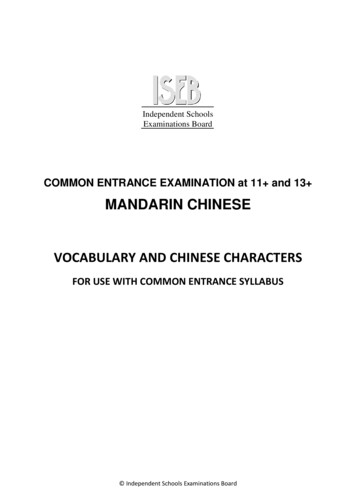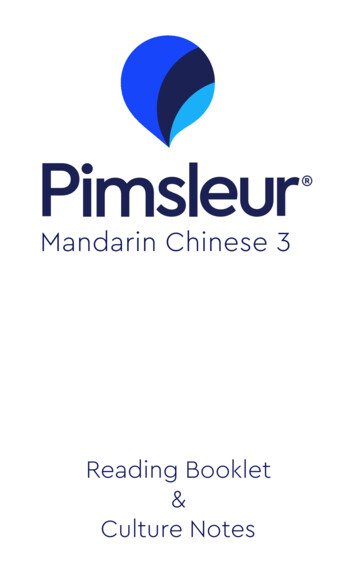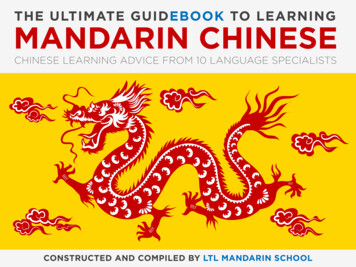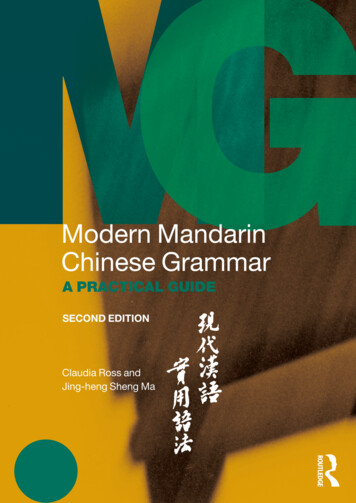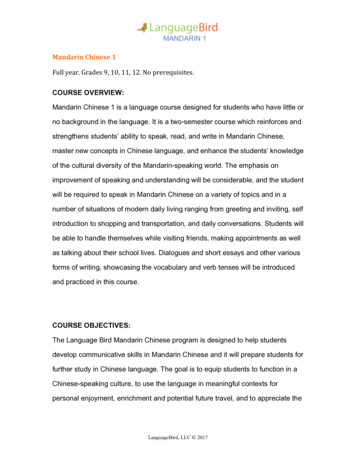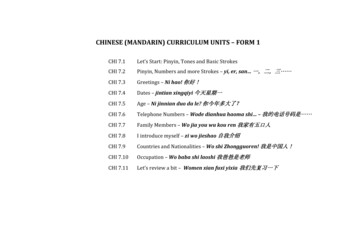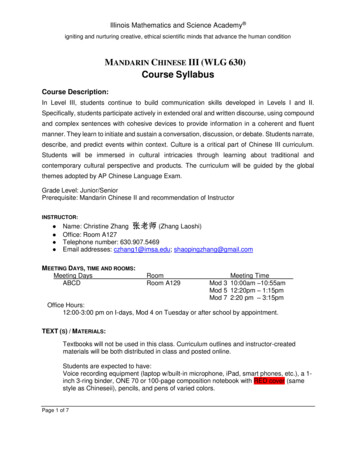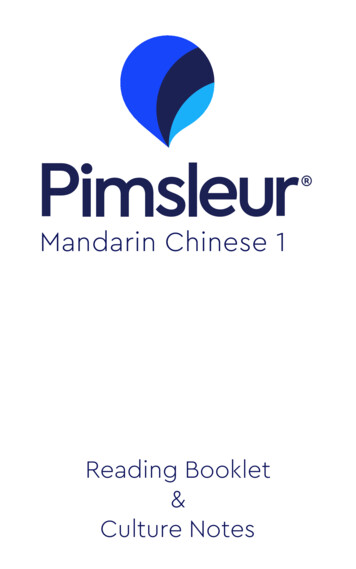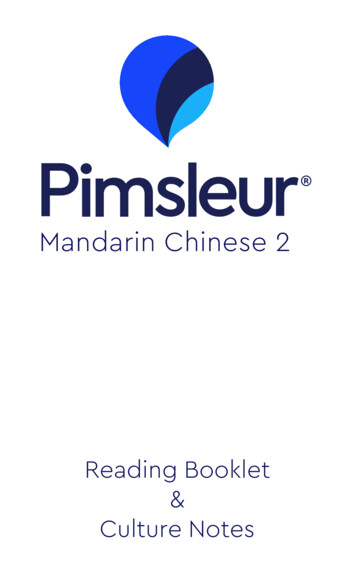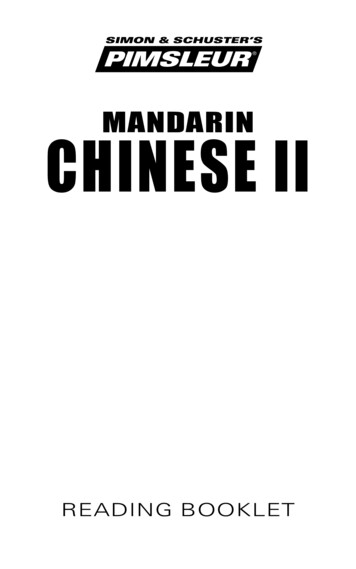
Transcription
SIMON & SCHUSTER’SPIMSLEUR MANDARINchinese IIreading booklet
Travelers should always check with theirnation's State Department for currentadvisories on local conditions beforetraveling abroad.Graphic Design: Maia Kennedy and ‰ Recorded Program 2002 Simon & Schuster, Inc. Reading Booklet 2002 Simon & Schuster, Inc.Pimsleur is an imprint of Simon & Schuster Audio,a division of Simon & Schuster, Inc. Mfg. in USA.All rights reserved.
MANDARINCHINESE IIACKNOWLEDGMENTSMANDARIN CHINESE IIVoicesEnglish-Speaking Instructor . . . . . . . . Ray BrownMandarin-Speaking Instructor . . . . . . . Qing RaoFemale Mandarin Speaker. . . . . . . Mei Ling DiepMale Mandarin Speaker . . . . . . . . . . . Yaohua ShiCourse WritersYaohua Shi Christopher J. GaintyReviewerZhijie JiaEditorsJoan Schoellner Beverly D. HeinleExecutive ProducerBeverly D. HeinleProducer & DirectorSarah H. McInnisRecording EngineersPeter S. Turpin Kelly SauxSimon & Schuster Studios, Concord, MAiii
TABLE OF CONTENTSNotesUnit 1Regional Accents . . . . . . . . . . . . . . . . . . . . . . 1Particles . . . . . . . . . . . . . . . . . . . . . . . . . . . . . 2Unit 2Dining Out . . . . . . . . . . . . . . . . . . . . . . . . . . . 3Chengde . . . . . . . . . . . . . . . . . . . . . . . . . . . . . 3Unit 3Alcoholic Beverages . . . . . . . . . . . . . . . . . . . 4Friends and Family. . . . . . . . . . . . . . . . . . . . . 5Unit 4Teahouses . . . . . . . . . . . . . . . . . . . . . . . . . . . . 6Women in the Workforce . . . . . . . . . . . . . . . . 7Unit 5Travel in China by Train and Plane . . . . . . . . 7Unit 6Stores and Shopping . . . . . . . . . . . . . . . . . . . 10Taiwan . . . . . . . . . . . . . . . . . . . . . . . . . . . . . . 10Unit 7Days and Months . . . . . . . . . . . . . . . . . . . . . . 12Unit 8Movies . . . . . . . . . . . . . . . . . . . . . . . . . . . . . . 14Popular Entertainment . . . . . . . . . . . . . . . . . . 15Unit 9Beijing Opera . . . . . . . . . . . . . . . . . . . . . . . . . 16Unit 10Business Travel . . . . . . . . . . . . . . . . . . . . . . . 17Coffee. . . . . . . . . . . . . . . . . . . . . . . . . . . . . . . 18iv
TABLE OF CONTENTSNotes (continued)Unit 11Holidays and Leisure Time . . . . . . . . . . . . . . 19Chinese Pastries . . . . . . . . . . . . . . . . . . . . . . . 20Modesty and Politeness . . . . . . . . . . . . . . . . . 20Unit 12Hangzhou . . . . . . . . . . . . . . . . . . . . . . . . . . . . 22Suzhou . . . . . . . . . . . . . . . . . . . . . . . . . . . . . . 23Unit 13Combating the Summer Heat . . . . . . . . . . . . . 24Forms of Address . . . . . . . . . . . . . . . . . . . . . . 25Unit 14Travel outside China . . . . . . . . . . . . . . . . . . . 26The “Three Links” . . . . . . . . . . . . . . . . . . . . . 27Unit 15Personal Questions . . . . . . . . . . . . . . . . . . . . . 28China’s One-Child Policy . . . . . . . . . . . . . . . 30Unit 16The Phone System . . . . . . . . . . . . . . . . . . . . . 31Banks . . . . . . . . . . . . . . . . . . . . . . . . . . . . . . . 32Unit 17zhongguo . . . . . . . . . . . . . . . . . . . . . . . . . . . . 33Measurements . . . . . . . . . . . . . . . . . . . . . . . . 34Unit 18Chinese Students Abroad . . . . . . . . . . . . . . . . 35Unit 19Medical Care . . . . . . . . . . . . . . . . . . . . . . . . . 37Traditional Chinese Medicine . . . . . . . . . . . . 38v
TABLE OF CONTENTSNotes (continued)Unit 20E-mail and Internet Cafés . . . . . . . . . . . . . . . 40Shanghai . . . . . . . . . . . . . . . . . . . . . . . . . . . . 41Unit 21The Postal System . . . . . . . . . . . . . . . . . . . . . 42Chinese Word Order . . . . . . . . . . . . . . . . . . . . 43Unit 22Sports and Board Games . . . . . . . . . . . . . . . . 45Unit 23Getting Around . . . . . . . . . . . . . . . . . . . . . . . 47Unit 24Parks. . . . . . . . . . . . . . . . . . . . . . . . . . . . . . . . 49Unit 25Currency. . . . . . . . . . . . . . . . . . . . . . . . . . . . . 50Unit 26Feng shui . . . . . . . . . . . . . . . . . . . . . . . . . . . . 52Unit 27Qingdao . . . . . . . . . . . . . . . . . . . . . . . . . . . . . 53Beijing . . . . . . . . . . . . . . . . . . . . . . . . . . . . . . 53Unit 28Boat Travel . . . . . . . . . . . . . . . . . . . . . . . . . . . 54Unit 29Nanjing . . . . . . . . . . . . . . . . . . . . . . . . . . . . . 55Tianjin . . . . . . . . . . . . . . . . . . . . . . . . . . . . . . 56Unit 30English in China . . . . . . . . . . . . . . . . . . . . . . . 57vi
MANDARIN CHINESE IIUnit 1Regional AccentsMandarin, China’s standard spoken language, istaught in schools throughout Mainland China andTaiwan. It has become even more widespread throughthe reach of television. Today virtually all young peopleon both sides of the Taiwan Strait understand and speakMandarin, in addition to their native dialects.As you might expect, the degree of fluency varies.Few people in the South can reproduce the kind ofMandarin heard on television or in films. For instance,when southerners speak Mandarin, they tend to stressevery syllable. The “soft sound,” also known as the“neutral tone,” is often absent from their speech.Whereas Northerners will leave particles and the lastsyllable of certain compound words unstressed, peoplefrom Taiwan or Hong Kong are more likely to giveequal stress to each syllable. For example, Northernerswill pronounce the word that means “to be acquaintedwith” as renshi (falling and neutral tones), whileSoutherners will pronounce it ren shì, stressing thelast syllable and giving it its full dictionary tonal value.The neutral tone always occurs in the last syllable ofa compound word. The absence of this tone does notusually cause confusion or misunderstanding, but itdoes mark the speaker as a Southerner.
MANDARIN CHINESE IIUnit 1 (continued)ParticlesIn Chinese, particles, such as le, de, and ne,perform a number of important functions; for thisreason, they are sometimes called “function words.”For instance, to indicate that an action has alreadytaken place, you add le to the verb: chi le, “ate;” kanle, “saw.” The particle de can indicate possession:wo de shu, “my book.” You have also come acrossne as in ni ne, “What about you?” Some particles,including these three, are always pronouncedwith the neutral tone. The word “neutral” is usedbecause their exact tonal value depends on that ofthe preceding syllable. Whatever tonal value theyacquire in natural speech is barely audible. That iswhy they are also said to be “soft.”2
MANDARIN CHINESE IIUnit 2Dining OutApart from the imperial cuisine associated withthe Manchu emperors, in the past Beijing was notparticularly known for fine dining. The restaurantscene, however, has changed dramatically in recentyears. Now thousands of restaurants featuring avast array of cooking styles dot the city. Good andinexpensive local food is plentiful, as well as exoticfare from all over the world. As people become moreand more affluent, they are increasingly dining out.One of the most famous traditional restaurants inBeijing is Quanjude. Its Peking duck is renownedthroughout China.ChengdeChengde is a resort city about 135 miles northeastof Beijing. In 1703 Emperor Kangxi built a summerpalace in what was then an obscure provincial town.Eventually the palace grew to the size of Beijing’sSummer Palace and the Forbidden City combined.The summer retreat, called Bishu shanzhuang, orHeat-Fleeing Mountain Villa, boasts a vast park.Because their empire was both large and multiethnic, the imperial family made a concerted effort3
MANDARIN CHINESE IIUnit 2 (continued)to appease the Mongolians and other followers ofTibetan and Mongolian Buddhism. To this endthey built a group of Lamaist monasteries to thenorth of the palace. Recently the local governmenthas restored many of the palace structures andmonasteries for the sake of tourism. UNESCO hasdesignated the former imperial Summer Palace atChengde a World Heritage Site.Unit 3Alcoholic BeveragesAmong urban and westernized Chinese, beeris the most popular alcoholic beverage. Despitejoint ventures with international wine makers, theproduction and consumption of wine lag far behindthat of beer. Many people, however, prefer Chinesehard liquor to either beer or wine. A formal mealor banquet would not be complete without whatthe Chinese call bai jiu, or white liquor made fromgrains. Rice wine, served warm, is popular incertain parts of China as well. Almost all liquor isconsumed to accompany food.4
MANDARIN CHINESE IIUnit 3 (continued)Although many people have heard of cocktails,they are not common even among Chinese who arereasonably familiar with western ways.Friends and FamilyForeigners visiting China are most likely tointeract with the Chinese in a business setting. Aftera meeting, guests are often treated to a lavish multicourse meal in a fancy restaurant or hotel. Sometourist agencies also arrange for tourists to spenda day with a Chinese family. Away from touristhotels and official interpreters, however, spontaneous invitations to one’s home are infrequent.Since most Chinese live in cramped apartments,they are less inclined to invite friends to their homethan are Americans. Relatives, of course, are anothermatter. While three generations living under oneroof is becoming increasingly rare, especially inurban areas, close relatives still frequently visitone another.5
MANDARIN CHINESE IIUnit 4TeahousesTeahouses were once ubiquitous in market townsand other urban centers in China. The mainly maleclientele went to teahouses not only to quench theirthirst, but also to socialize. To attract more patrons,teahouses provided various forms of entertainmentsuch as storytelling and puppet theater. Although tearemains the most popular non-alcoholic beveragetoday, during the 1960s teahouses virtually disappeared from the Chinese urban landscape, as theywere replaced by modern, western-style theaters,cinemas, and the like. In recent years, as the Chinesebecome more and more affluent, teahouses aremaking a comeback. Many of the new teahousesfeature antique furniture or old farming implements to play on people’s sense of nostalgia. Sanwei shu wu is named after a story by the famousearly twentieth century writer Lu Xun. San weishu wu literally means the Studio of Three Flavors(meaning, “diverse flavors”).6
MANDARIN CHINESE IIUnit 4 (continued)Women in the WorkforceThe percentage of women working outside thehome is quite high in China. In cities, virtually allwomen have jobs. As in the U. S., women dominatecertain professions, such as teaching and nursing.There are also many women doctors and scientists.In other important areas, however, they haven’t yetachieved parity with men. Women who occupypositions of power are still rare. The burden ofrestructuring the manufacturing industries in thelast twenty years has also fallen more heavily onwomen, as they are more likely to be laid off thantheir male counterparts. Older, unskilled women inparticular have difficulty finding a job.Unit 5Travel in China by Train and PlaneThe transportation system in China has seen vastimprovements in recent years. The coastal areasare well served by an ever-expanding network ofrailroads and highways, while all over the country,numerous airports have been built or expanded.7
MANDARIN CHINESE IIUnit 5 (continued)Trains, often packed to capacity, are the traditionalpeople-movers in China. Instead of first or secondclass, passengers choose hard seat, hard sleeper,soft seat, or soft sleeper. Despite its name, hard seatis in fact not hard, but padded. Since those faresare the cheapest, hard seat is often uncomfortablycrowded. By contrast, a sleeper carriage can accommodate only a limited number of people. There arehalf a dozen bunks in three tiers; sheets, pillows,and blankets are provided. On short distancessome trains have soft seats, which cost about thesame as hard sleeper. In soft seat, overcrowdingand smoking are not permitted. Soft sleeper is theultimate luxury, with four comfortable bunks in aclosed compartment complete with wood paneling,potted plants, lace curtains, and often air-conditioning. Since few Chinese can afford soft sleeper,tickets, which cost twice as much as those for hardsleeper, are easy to obtain.China has many different types of trains, althoughthere are three main ones: slow, direct express,and special express. The zhike and ke, colloquiallyknown as manche or “slow trains,” stop at everystation. Some of these are still powered by steamengines. The faster direct express zhikuai makefewer stops. For a surcharge, passengers can take8
MANDARIN CHINESE IIUnit 5 (continued)one that runs at a higher speed. The special expresstekuai make the least number of stops and are usuallyfueled by diesel or by electricity. For a still fasterspecial express train, the surcharge for higher speedis roughly twice that of the direct express.Conditions in trains have also improved considerably. Faced with stiff competition from airlinesand long distance buses, the state-owned railbureaus have tried to introduce faster and cleanerservices, especially to tourist destinations. A superspeed railway between Beijing and Shanghai is inthe planning stage.In the past few years, air travel has becomeincreasingly popular. There are now frequentflights between major cities. Furthermore, modernBoeings and Airbuses have for the most part replacedthe earlier rickety Soviet-built planes that causedwestern tourists much consternation.9
MANDARIN CHINESE IIUnit 6Stores and ShoppingShopping is a favorite pastime for many Chinese.Department stores in major cities remain open wellafter 9:00 PM Western-style convenience storeshave also appeared in big cities; so has warehousemerchandizing.Many of the more populardepartment stores and supermarkets are joint ventureswith international retail giants. Service standardsin these upscale commercial establishments, stilllimited in number, are comparable to those of theirwestern counterparts. Design
Pimsleur is an imprint of . Mandarin, China’s standard spoken language, is taught in schools throughout Mainland China and Taiwan. It has become even more widespread through the reach of television. Today virtually all young people on both sides of the Taiwan Strait understand and speak Mandarin, in addition to their native dialects. As you might expect, the degree of fluency varies .
